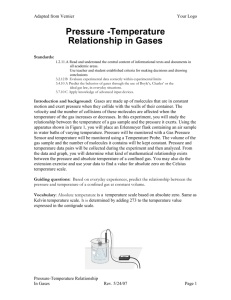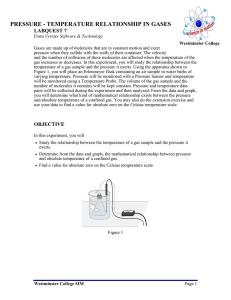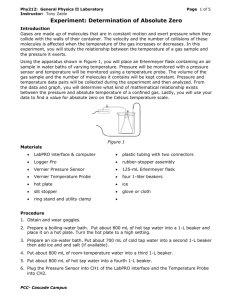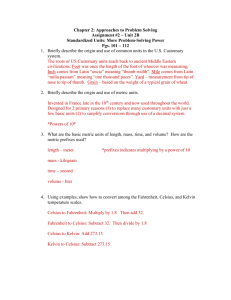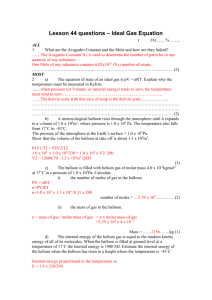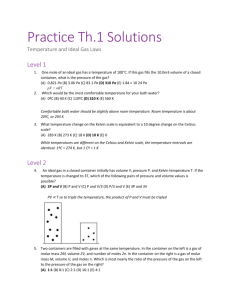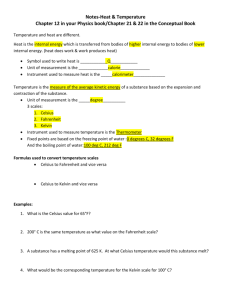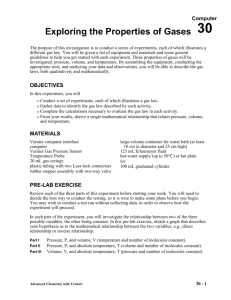Pressure-Temperature
advertisement
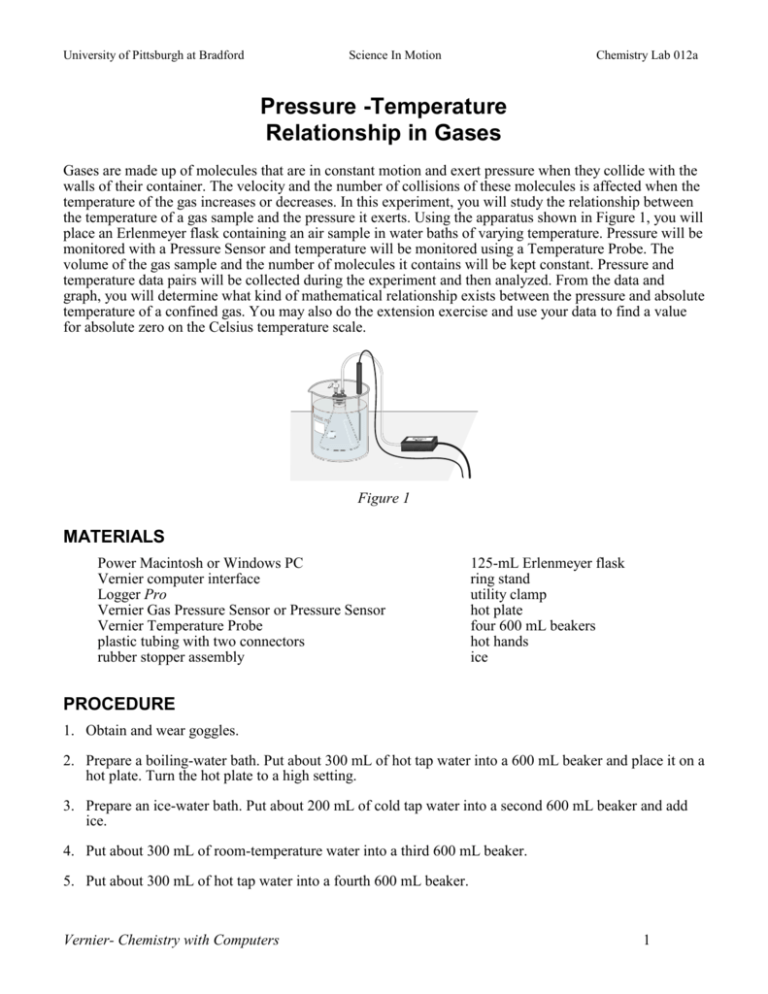
University of Pittsburgh at Bradford Science In Motion Chemistry Lab 012a Pressure -Temperature Relationship in Gases Gases are made up of molecules that are in constant motion and exert pressure when they collide with the walls of their container. The velocity and the number of collisions of these molecules is affected when the temperature of the gas increases or decreases. In this experiment, you will study the relationship between the temperature of a gas sample and the pressure it exerts. Using the apparatus shown in Figure 1, you will place an Erlenmeyer flask containing an air sample in water baths of varying temperature. Pressure will be monitored with a Pressure Sensor and temperature will be monitored using a Temperature Probe. The volume of the gas sample and the number of molecules it contains will be kept constant. Pressure and temperature data pairs will be collected during the experiment and then analyzed. From the data and graph, you will determine what kind of mathematical relationship exists between the pressure and absolute temperature of a confined gas. You may also do the extension exercise and use your data to find a value for absolute zero on the Celsius temperature scale. Figure 1 MATERIALS Power Macintosh or Windows PC Vernier computer interface Logger Pro Vernier Gas Pressure Sensor or Pressure Sensor Vernier Temperature Probe plastic tubing with two connectors rubber stopper assembly 125-mL Erlenmeyer flask ring stand utility clamp hot plate four 600 mL beakers hot hands ice PROCEDURE 1. Obtain and wear goggles. 2. Prepare a boiling-water bath. Put about 300 mL of hot tap water into a 600 mL beaker and place it on a hot plate. Turn the hot plate to a high setting. 3. Prepare an ice-water bath. Put about 200 mL of cold tap water into a second 600 mL beaker and add ice. 4. Put about 300 mL of room-temperature water into a third 600 mL beaker. 5. Put about 300 mL of hot tap water into a fourth 600 mL beaker. Vernier- Chemistry with Computers 1 Pressure-Temperature Relationship in Gases 6. Prepare the Temperature Probe and Pressure Sensor for data collection. a. Plug the Temperature Probe into Channel 1 of the computer interface.. b. Plug the Pressure Sensor into Channel 2 of the interface. c. Identify which type of Vernier Pressure Sensor you are using: Newer Vernier Gas Pressure Sensors have a white stem protruding from the end of the sensor box. Older Vernier Pressure Sensors have a 3-way valve at the end of a plastic tube leading from the sensor box. Before proceeding with the next step, align the blue handle with the stem of the 3-way valve that will not be used, as shown in Figure 2—this will close this stem. Figure 2 d. Obtain a rubber-stopper assembly with a piece of heavy-wall plastic tubing connected to one of its two valves. Attach the connector at the free end of the plastic tubing to the open stem of the Pressure Sensor with a clockwise turn. Leave its two-way valve on the rubber stopper open (lined up with the valve stem as shown in Figure 3) until Step 6f. e. Insert the rubber-stopper assembly into a 125-mL Erlenmeyer flask. Important: Twist the stopper into the neck of the flask to ensure a Figure 3 tight fit. Figure 4 f. Close the 2-way valve above the rubber stopper—do this by turning the valve handle so it is perpendicular with the valve stem itself (as shown in Figure 4). The air sample to be studied is now confined in the flask. 7. Prepare the computer for data collection by opening the Experiment 7 folder from Chemistry with Computers. Then open the experiment file that matches the pressure sensor and temperature probe you are using. The vertical axis has pressure scaled from 0 to 150 kPa. The horizontal axis has temperature scaled from 0 to 100°C. 8. Click Collect to begin data collection. 9. Collect pressure vs. temperature data for your gas sample: a. Place the flask into the ice-water bath. Make sure the entire flask is covered (see Figure 4). Stir. b. Place the temperature probe into the ice-water bath. c. When the pressure and temperature readings displayed in the Meter window stabilize, click Keep . You have now saved the first pressure-temperature data pair. 10. Repeat the Step-9 procedure using the room-temperature bath. 11. Repeat the Step-9 procedure using the hot-water bath. Vernier - Chemistry with Computers 2 Pressure-Temperature Relationship in Gases 12. Use a ring stand and utility clamp to suspend the temperature probe in the boiling-water bath. To keep from burning your hand, hold the tubing of the flask using a glove or a cloth. After the temperature probe has been in the boiling water for a few seconds, place the flask into the boiling-water bath and repeat the Step-9 procedure. Remove the flask and the temperature probe after you have clicked Keep . CAUTION: Do not burn yourself or the probe wires with the hot plate. 13. Click Stop when you have finished collecting data. Turn off the hot plate. Record the pressure and temperature values in your data table, or, if directed by your instructor, print a copy of the Table window. 14. Examine your graph of pressure vs. temperature (°C). In order to determine if the relationship between pressure and temperature is direct or inverse, you must use an absolute temperature scale; that is, a temperature scale whose 0° point corresponds to absolute zero. We will use the Kelvin absolute temperature scale. Instead of manually adding 273° to each of the Celsius temperatures to obtain Kelvin values, you can create a new data column for Kelvin temperature. a. Choose New Column Formula from the Data menu. b. Enter “Temp Kelvin” as the Long Name, “T Kelvin” as the Short Name, and “K” as the Unit. Then click on the Definition tab. c. Enter the correct formula for the column into the Equation edit box. Type in “273+”. Then select “Temp Celsius” from the Variables list. In the Equation edit box, you should now see displayed: 273+“Temp Celsius”. Click OK . d. Click on the vertical-axis label, select “Pressure” (only), and click OK . In the same way, select “Temp Kelvin” to be displayed on the horizontal axis. 15. Decide if your graph of pressure vs. temperature (K) represents a direct or inverse relationship: a. Click the Curve Fit button, . b. Choose your mathematical relationship from the list at the lower left. If you think the relationship is linear (or direct), use Linear (y = mx + b). If you think the relationship represents a power, use Power (y = Ax^b). Click Try Fit . c. A best-fit curve will be displayed on the graph. Click OK . If you made the correct choice, the curve should match up well with the points. If the curve does not match up well, try a different mathematical function and click Try Fit again. When the curve has a good fit with the data points, then click OK . d. Autoscale both axes starting with zero, double-click in the center of the graph to view Graph Options, click the Axis Options tab, and select Autoscale from 0 for both axes. 16. Print a copy of the graph of pressure vs. temperature (K). The regression line should still be displayed on the graph. Print a copy of the Graph window. Enter your name(s) and the number of copies you want to print. PROCESSING THE DATA 1. In order to perform this experiment, what two experimental factors were kept constant? 2. Based on the data and graph that you obtained for this experiment, express in words the relationship between gas pressure and temperature. 3. Explain this relationship using the concepts of molecular velocity and collisions of molecules. 4. Write an equation to express the relationship between pressure and temperature (K). Use the symbols P, T, and k. Vernier - Chemistry with Computers 3 Pressure-Temperature Relationship in Gases 5. One way to determine if a relationship is inverse or direct is to find a proportionality constant, k, from the data. If this relationship is direct, k = P/T. If it is inverse, k = P•T. Based on your answer to Question 4, choose one of these formulas and calculate k for the four ordered pairs in your data table (divide or multiply the P and T values). Show the answer in the fourth column of the Data and Calculations table. How “constant” were your values? 6. According to this experiment, what should happen to the pressure of a gas if the Kelvin temperature is doubled? Check this assumption by finding the pressure at -73°C (200 K) and at 127°C (400 K) on your graph of pressure versus temperature. How do these two pressure values compare? DATA AND CALCULATIONS Pressure (kPa) Temperature (°C) Temperature (K) Constant, k (P / T or P•T) EXTENSION The data that you have collected can also be used to determine the value for absolute zero on the Celsius temperature scale. Instead of plotting pressure versus Kelvin temperature like we did above, this time you will plot Celsius temperature on the y-axis and pressure on the x-axis. Since absolute zero is the temperature at which the pressure theoretically becomes equal to zero, the temperature where the regression line (the extension of the temperature-pressure curve) intercepts the y-axis should be the Celsius temperature value for absolute zero. You can use the data you collected in this experiment to determine a value for absolute zero. absolute zero Pressure 1. Remove the Linear Regression box on the graph by clicking on its upper-right corner. 2. Click on the vertical-axis label, select “Temp Celsius” (only), and click select “Pressure” to be displayed on the horizontal axis. OK . In the same way, 3. Rescale the temperature axis from a minimum of -300°C to a maximum of 200°C. This may be done by clicking on the minimum or maximum value displayed on the graph axis and editing them. The pressure axis should be scaled from 0 kPa to 150 kPa. 4. Click the Linear Regression button, . A best-fit linear regression curve will be shown for the four data points. The equation for the regression line will be displayed in a box on the graph, in the form y = mx + b. The numerical value for b is the y-intercept and represents the Celsius value for absolute zero. 5. Print the graph of temperature (°C) vs. pressure, with the regression line and its regression statistics still displayed. Print a copy of the Graph window. Enter your name(s) and the number of copies you want to print. Clearly label the position and value of absolute zero on the printed graph. Vernier - Chemistry with Computers 4
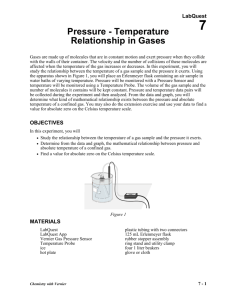
![Temperature Notes [9/22/2015]](http://s3.studylib.net/store/data/006907012_1-3fc2d93efdacd086a05519765259a482-300x300.png)

